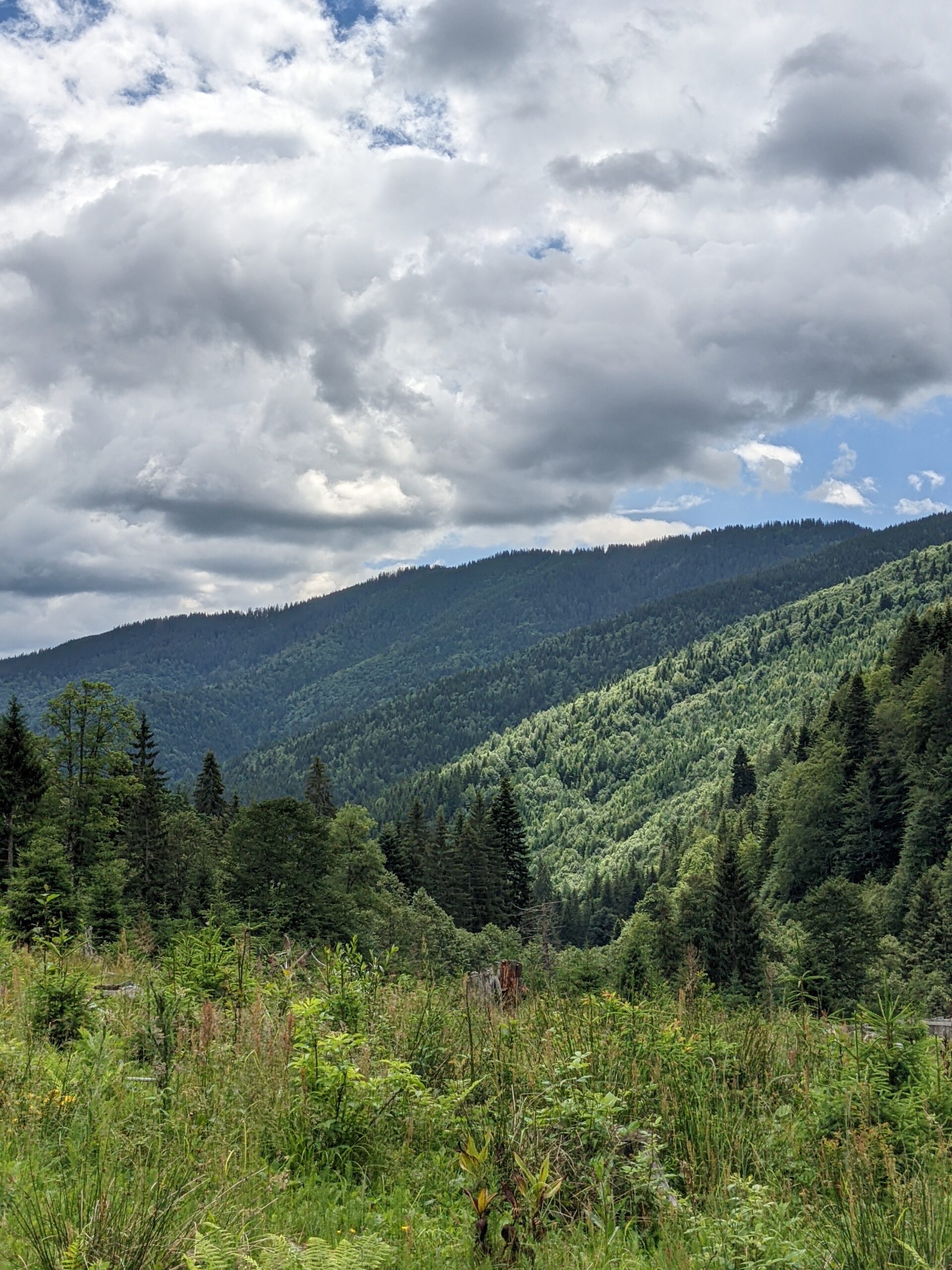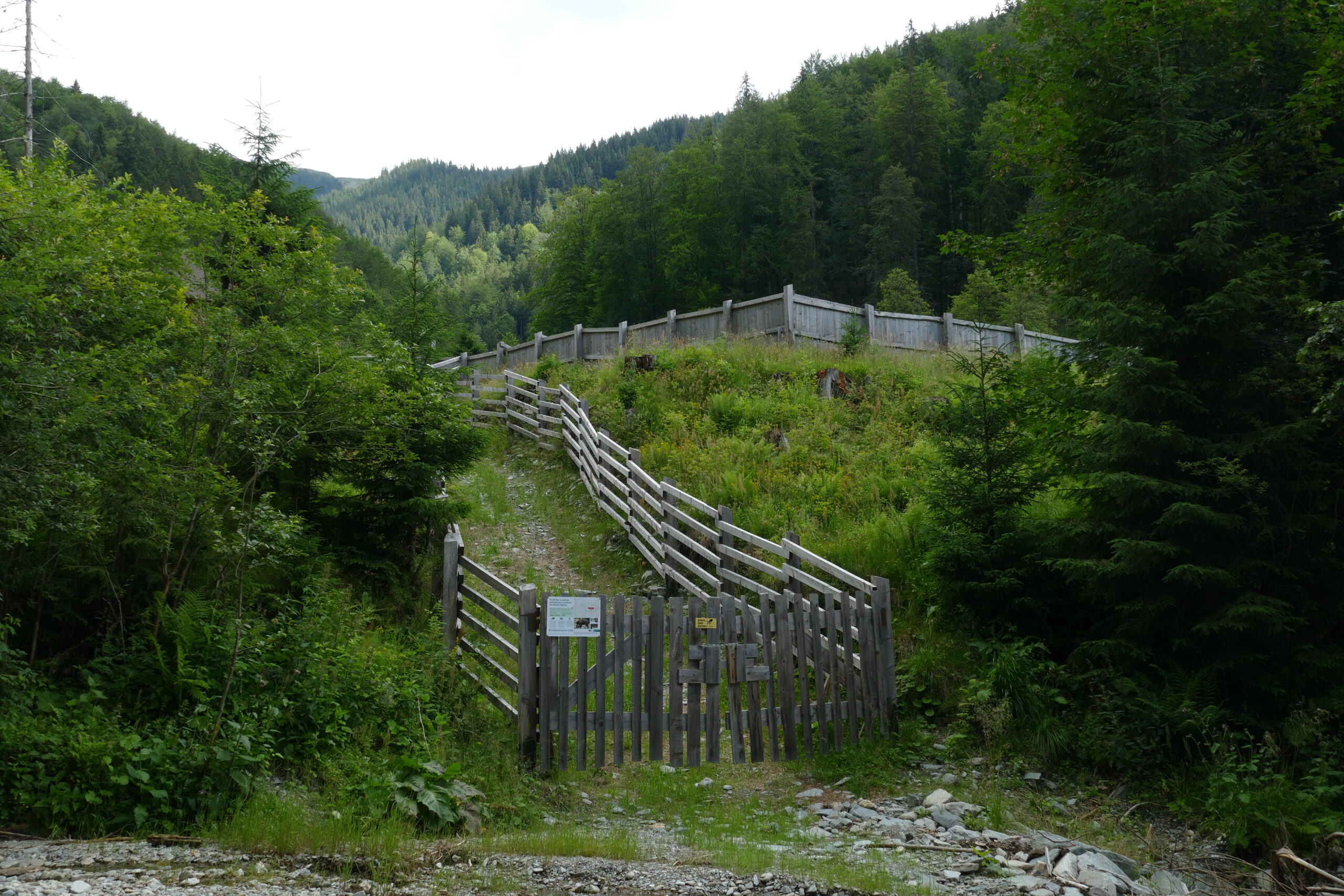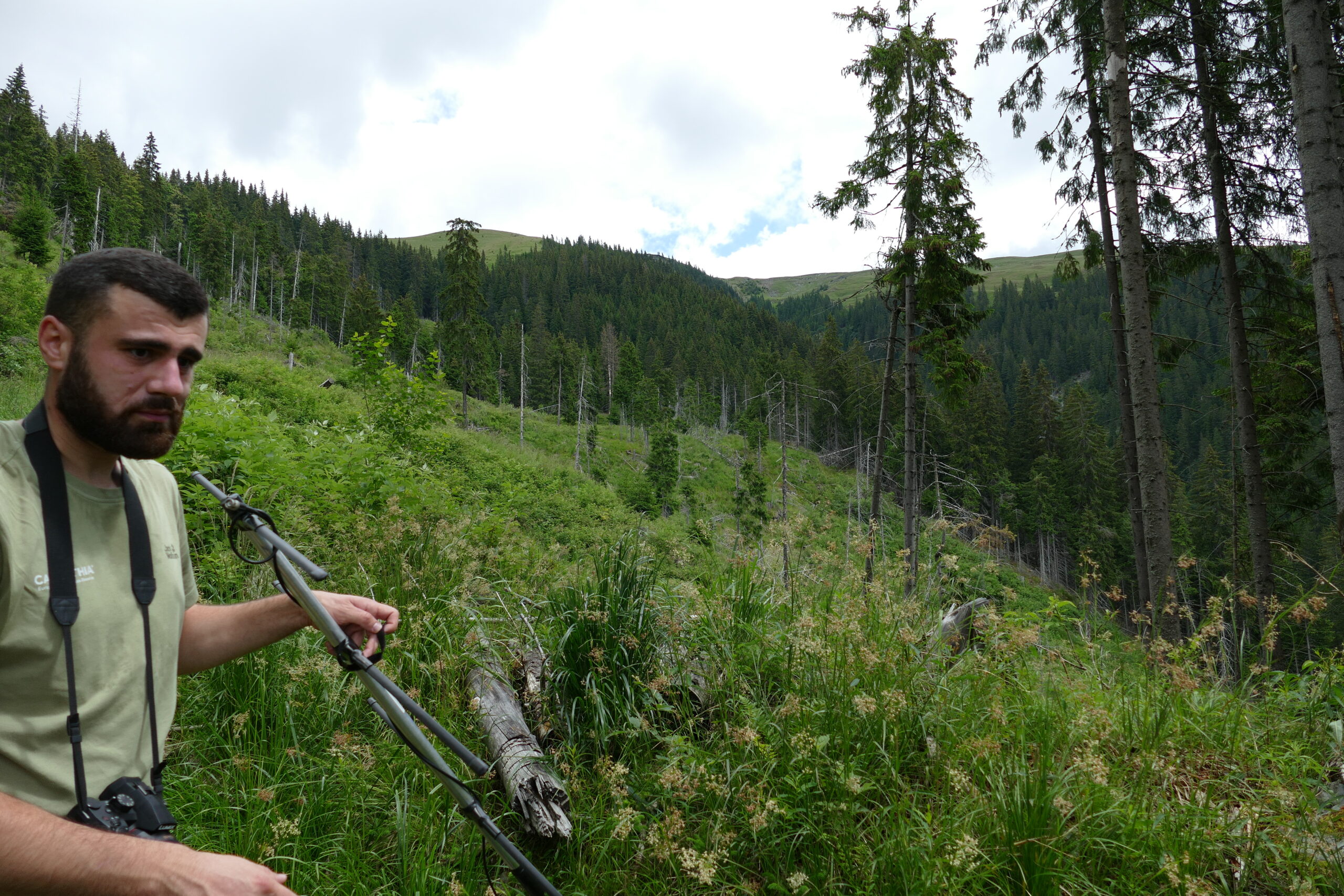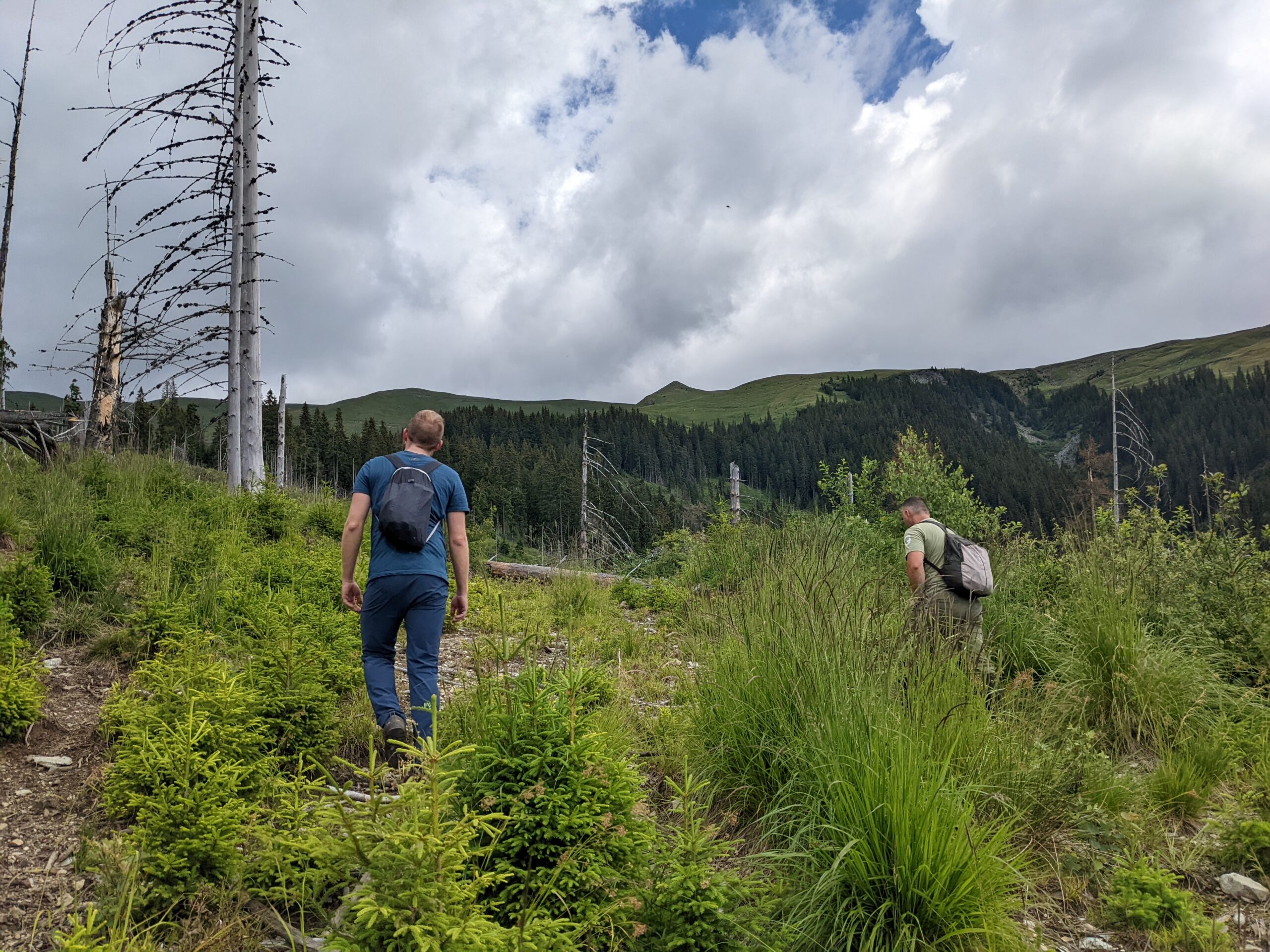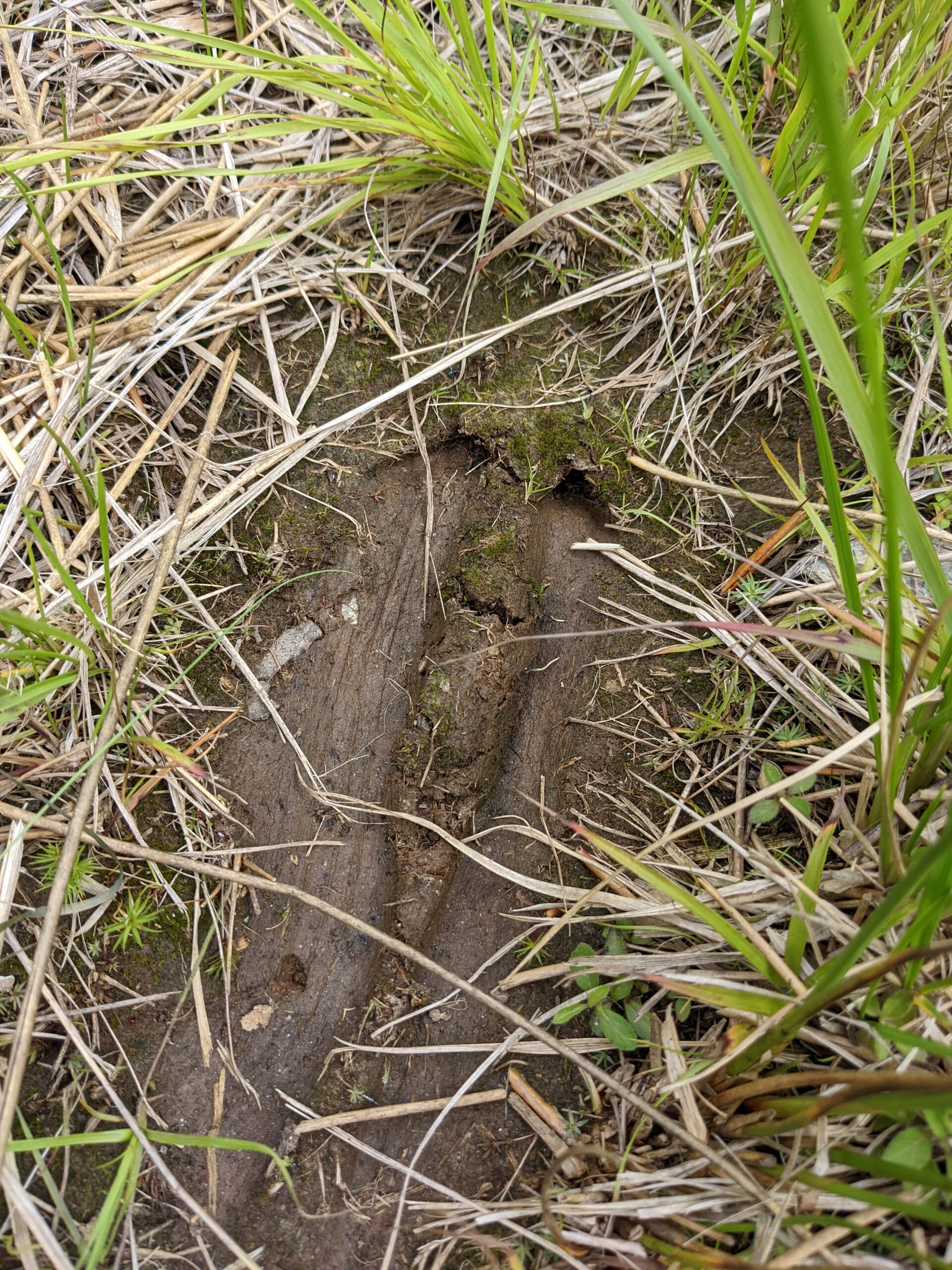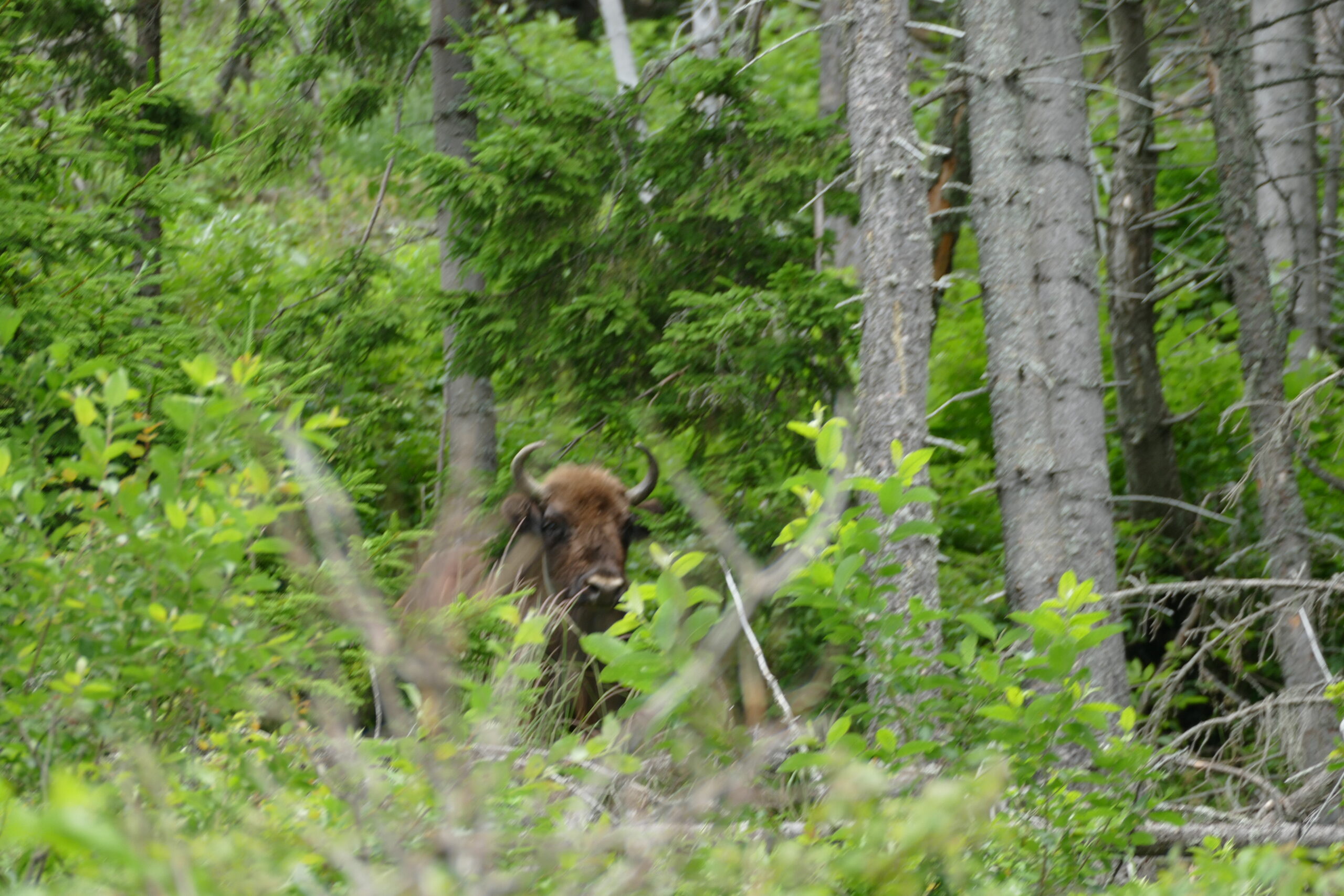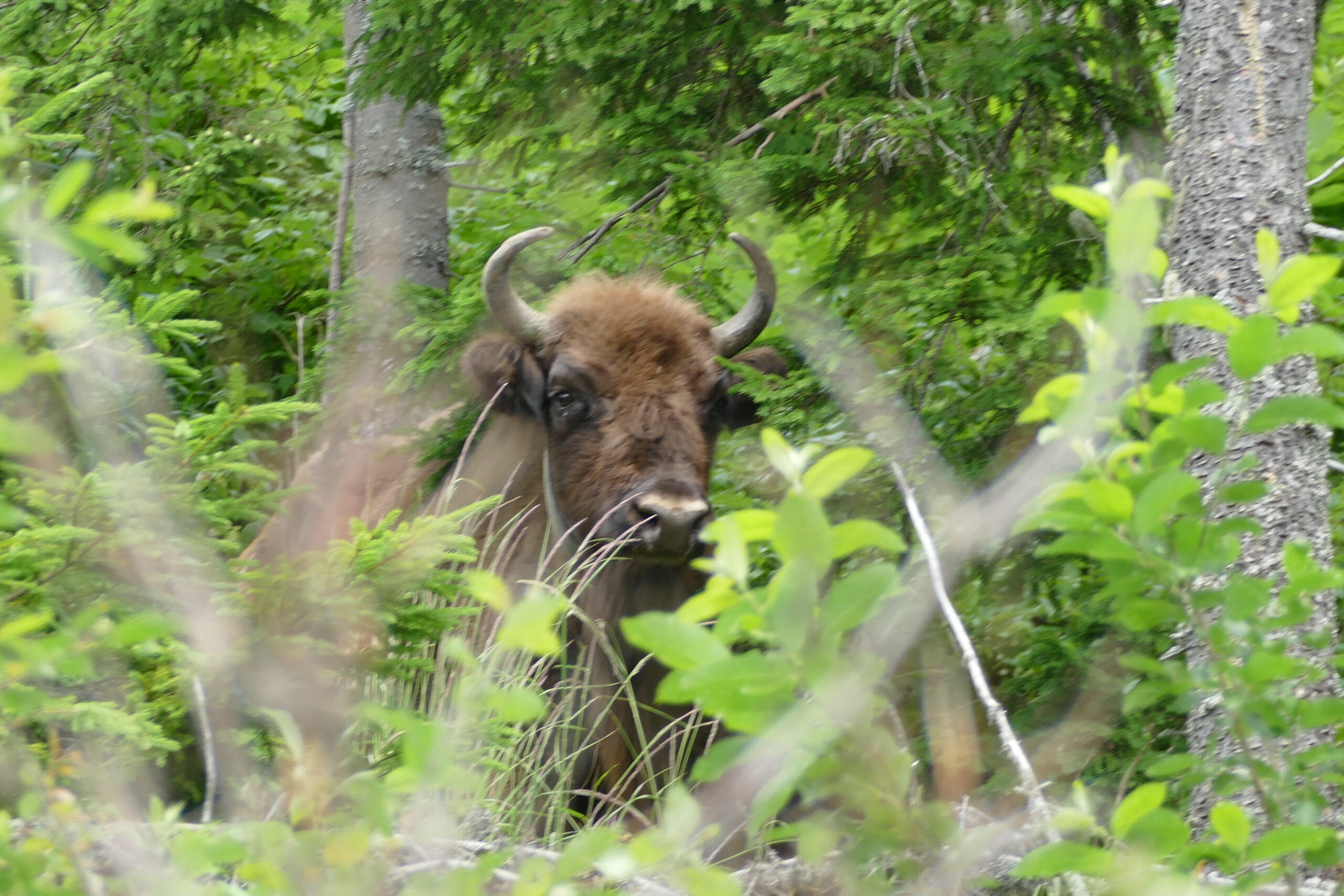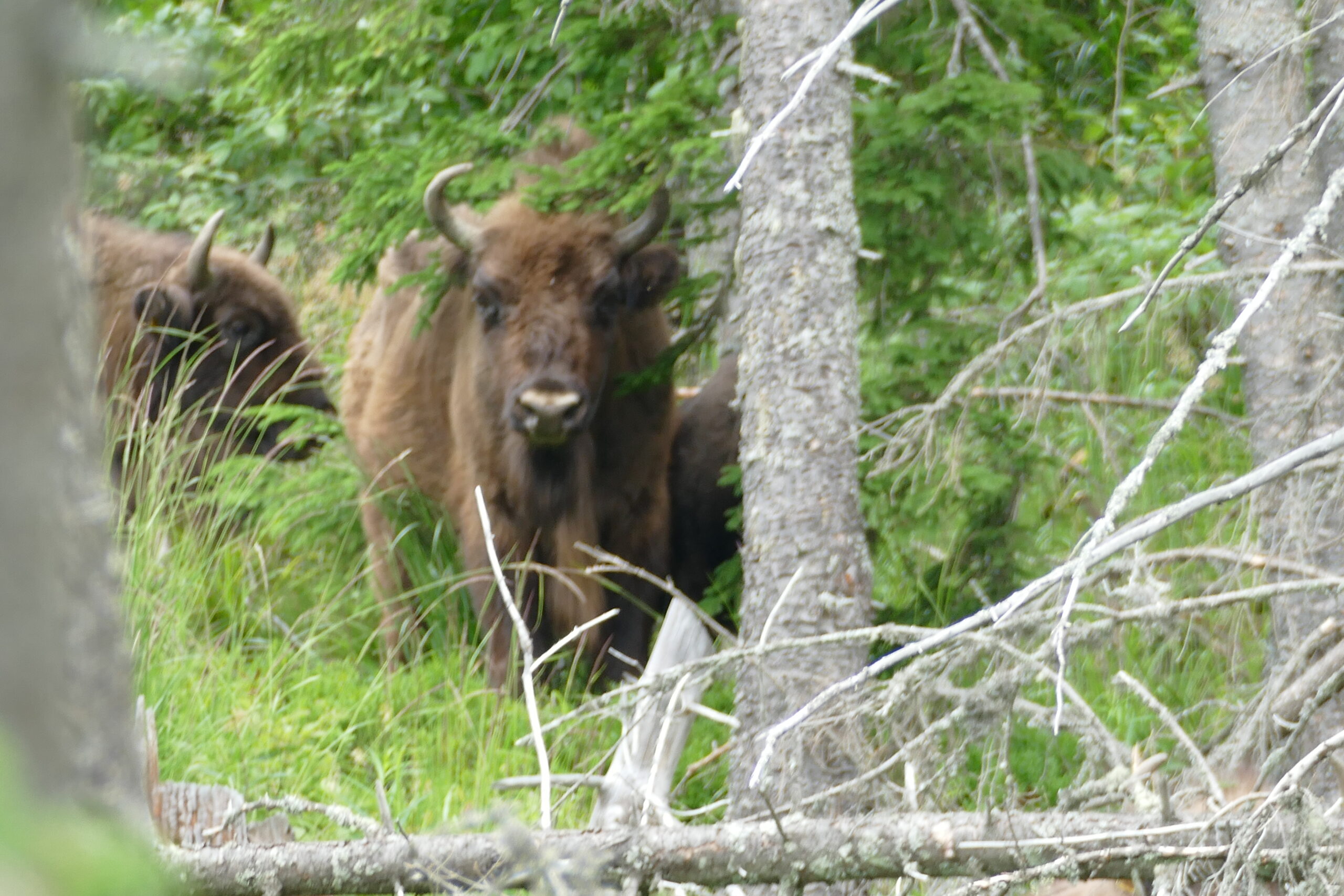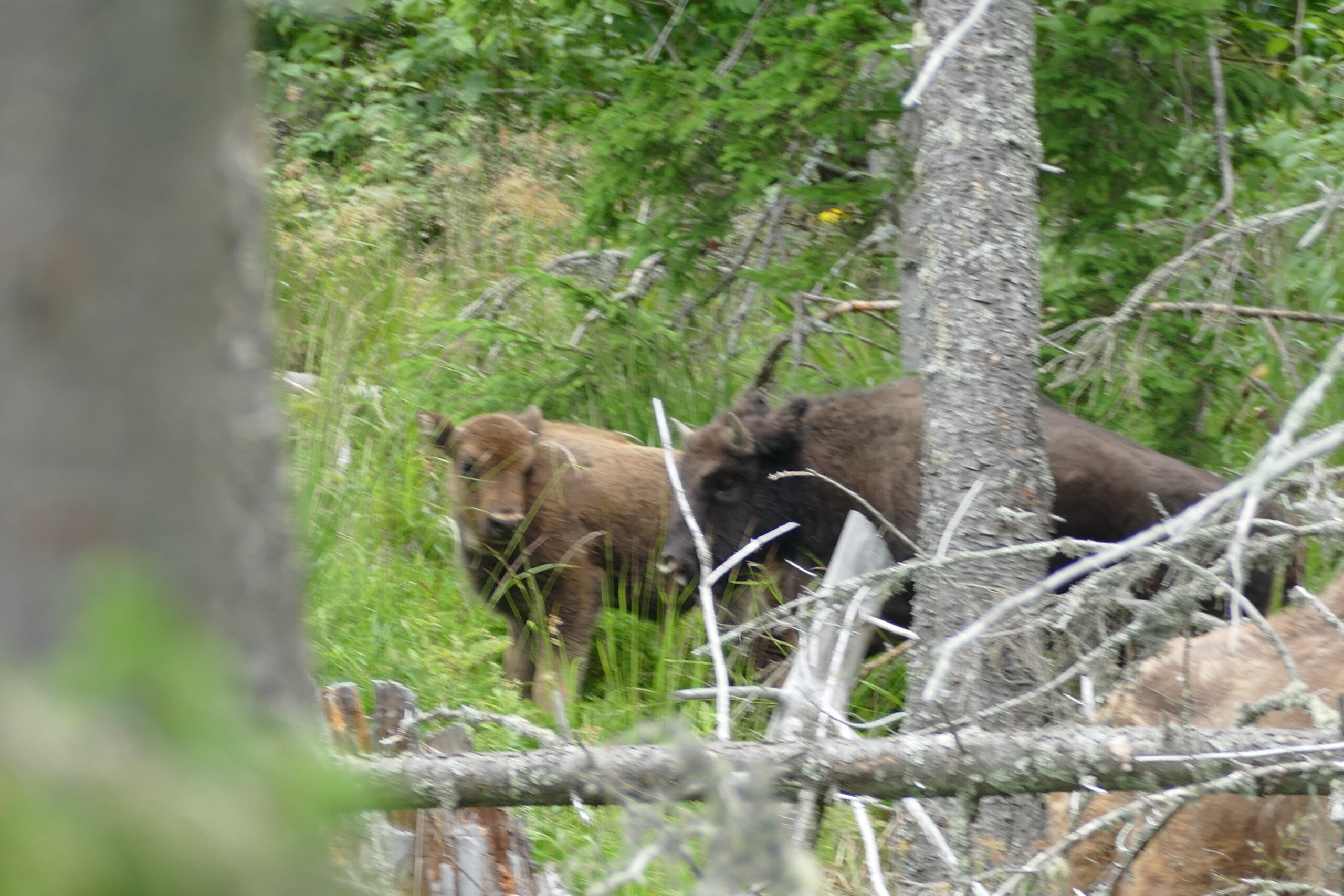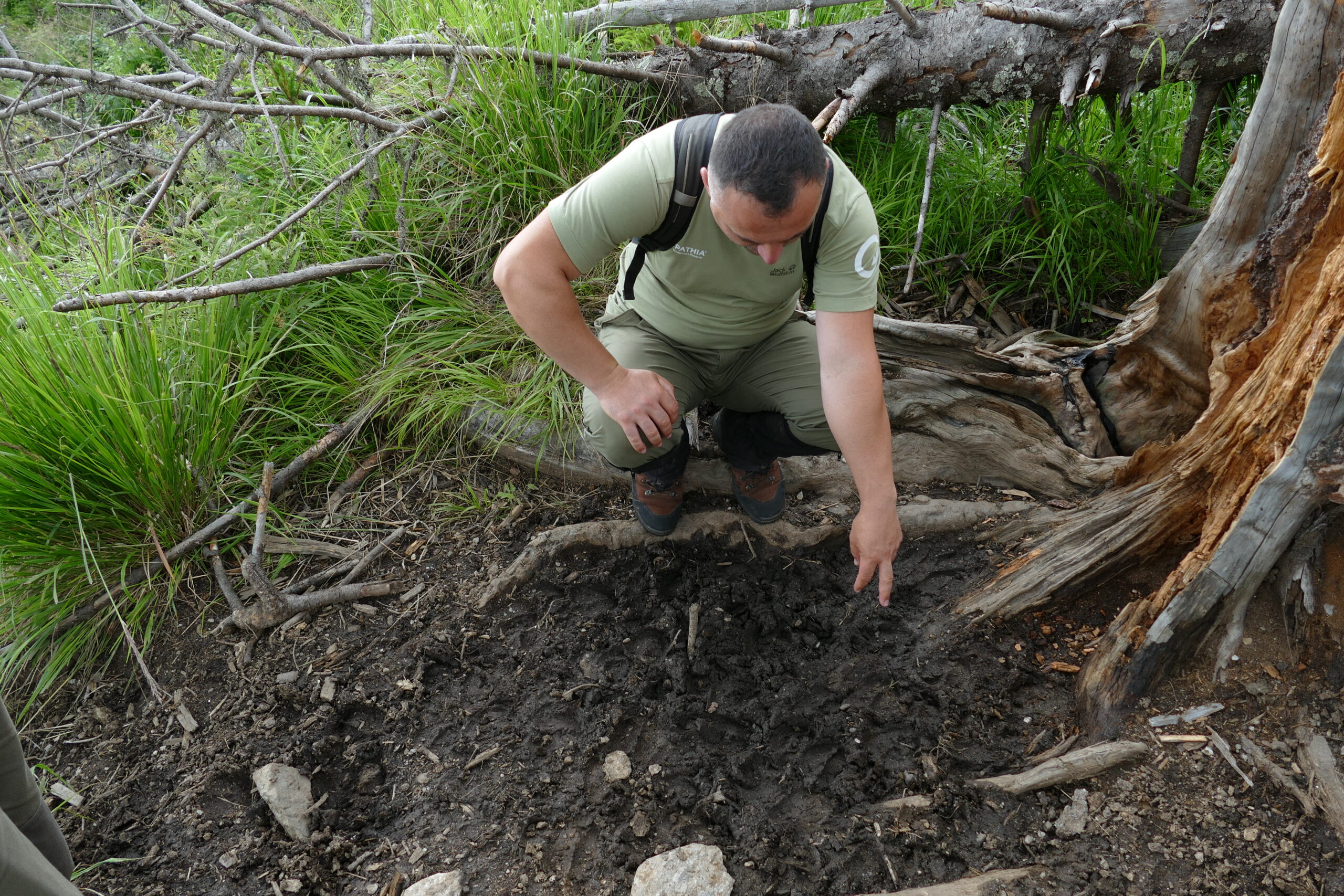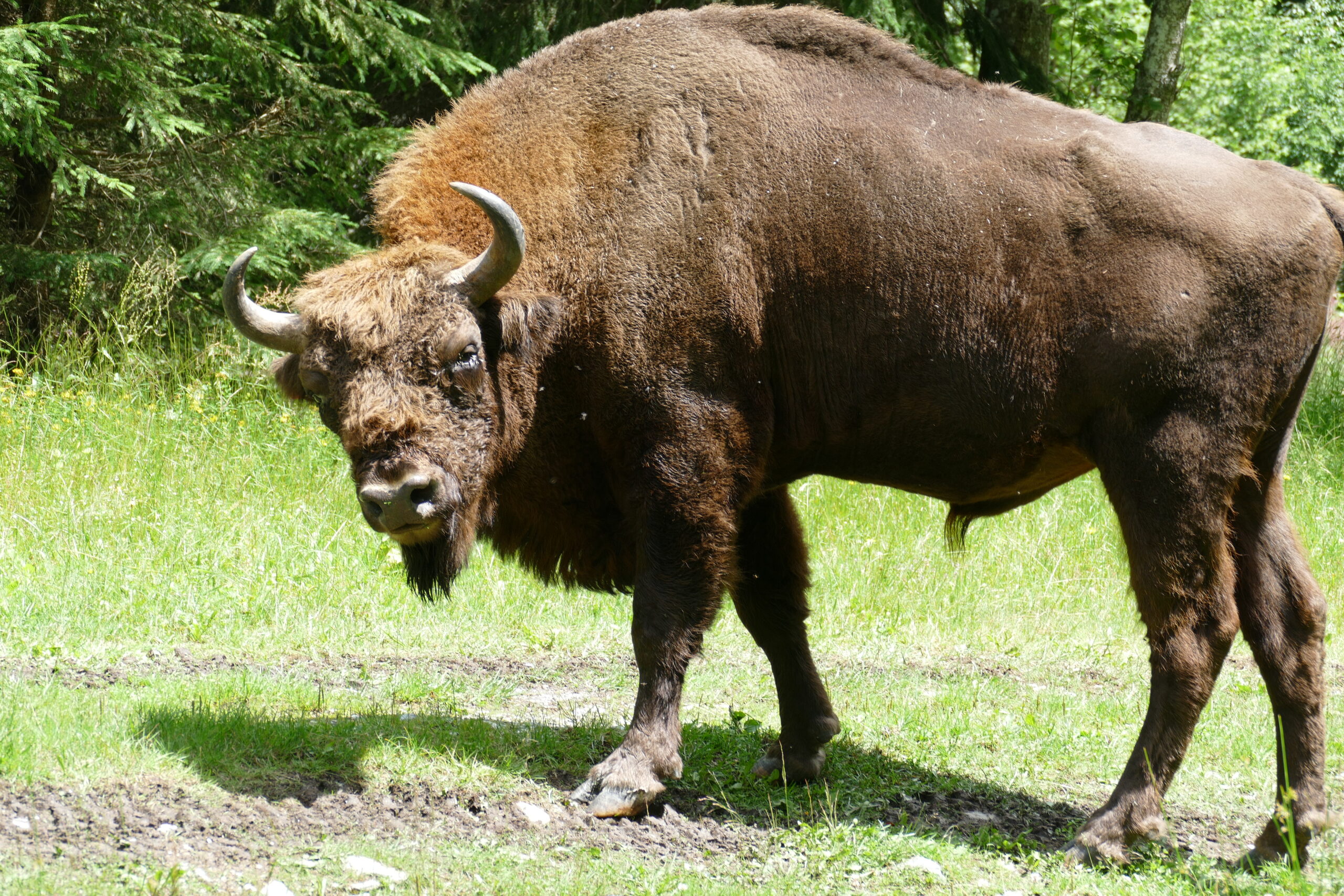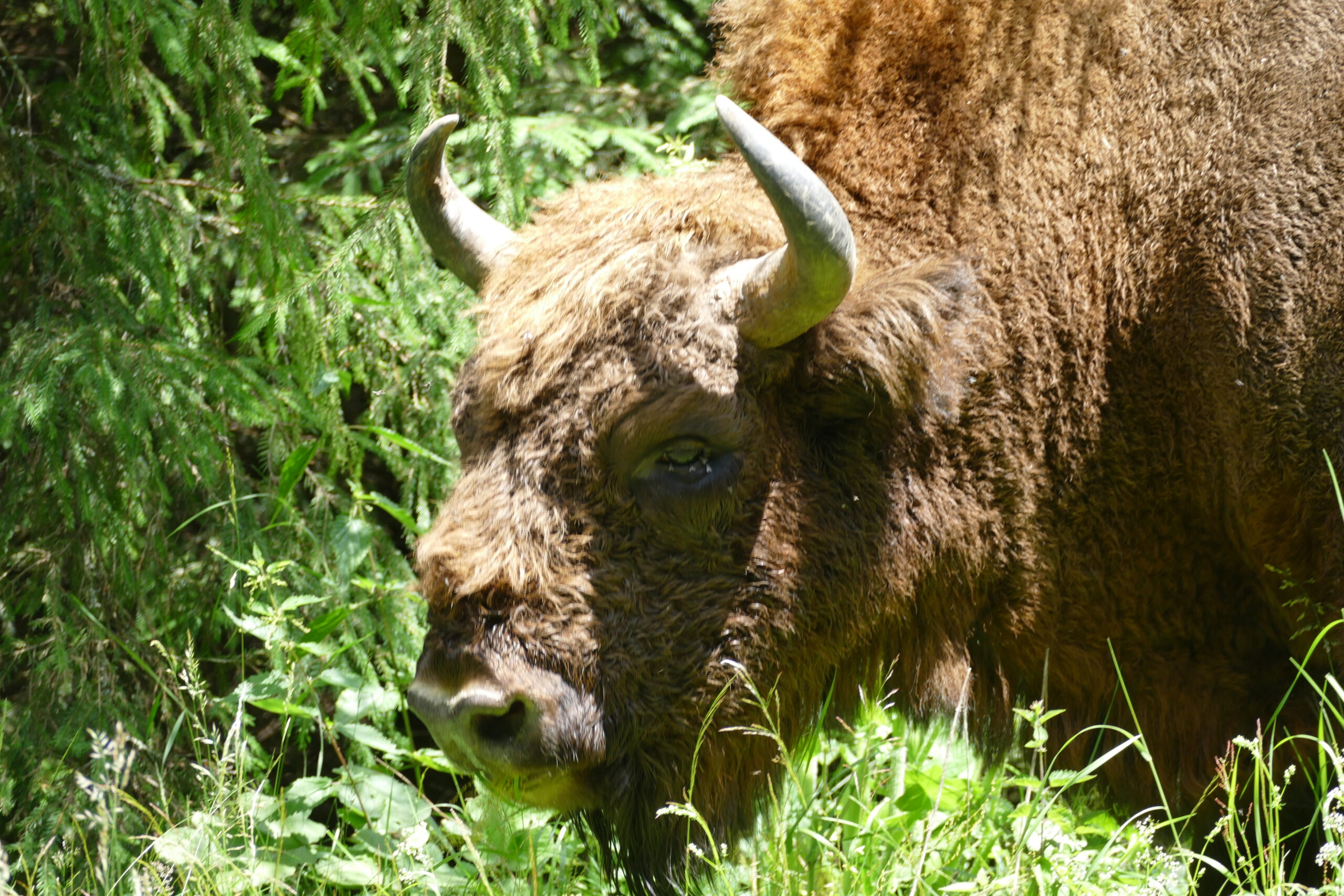On our second day with Conservation Carpathia, we joined Ionut and Robert, two rangers working on the reintroduction of the European bison to the Făgăraș mountains. CARPATHIA started with the reintroduction of this large herbivore three years ago, and by now there are four groups in two localities within the project area. We accompanied Ionut and Robert to the location close to the village Leresti, where the first bison, a young male, was introduced at the end of 2020. Bison males live solitarily, and groups are formed only by females and their offspring. Therefore, the group we aimed to find is formed of six females and, to our big joy, two young ones. These were the very first bison born here in the wild after the release, which shows the great success of this project in such a short timeframe. Ionut tells us that one of them was born in autumn 2021, and the other only two months ago. Apart from them, there are now three males roaming freely in this part of the Făgăraș.
Ionut and Robert are working full-time with the reintroduced bison. Their main task is to monitor their movement, behavior and health at all times and seasons. They go to the field daily, and we have the pleasure to join them today. Three females have GPS collars to make it easier to locate the group. The solitary males are not collared at all. Nevertheless, Ionut and Robert know these animals well, and can tell where they are usually grazing. So, we jump in the car with high hopes to see these majestic animals in the wild, for the first time in our lives.
The first bison after 200 years
In autumn 2019, CARPATHIA introduced first bison to the Făgăraș Mountains to the area of Pecineagu Lake. This happened after more than 200 years since their complete disappearance from the area. Shortly after, the organization started a second location in Lerești, which we are visiting today. And Ionut tells us that even a third area is in preparation. The bison reintroduction is part of a large-scale project called “Creation of a Wilderness Reserve in the Southern Carpathian Mountains, Romania”. The main purpose of the project is the restoration of the degraded habitats to allow natural processes benefitting biodiversity and local communities.
At least 100 bison are needed to ensure that they can effectively survive and multiply. Therefore, CARPATHIA aims to gradually release at least 30 individuals in three areas each. They also create the necessary conditions these bison to freely move across the Făgăraș and reproduce amongst the groups over time.
Reintroduction step-by-step
Driving to the place of start for our hike for the day, Ionut and Robert give us some background to the reintroduction, which is done in steps. When new bison arrive to the area, there are two enclosures created for them directly inside their future territory. They are first kept in a so-called quarantine enclosure for about one month which is 3 ha large and where they receive food and can recover from their journey. After this, they can move to the acclimatization enclosure for two more months, where they can roam on 100 ha and get used to their surroundings. Here they are also regularly visited by bears and wolves and learn to deal with the conditions of the terrain. During this acclimatization, the gates of the enclosures are increasingly open until the bison simply walk out into the wild. No fence, no barrier to keep them where humans want them.
Can we find something that doesn´t want to be found?
While we drive into the beautiful valley leading to the enclosures, Ionut tells us that Hyphen, the very first bison which arrived to this location, is “lazy” and likes to stay in the valley. As a 7-year-old solitary male, he likes his comfort and does not bother going into the mountains. This also means that passersby are able to spot him quite often – being two meters tall and weighing over one ton, he´s not an elusive animal. However, Ionut and Robert explain to us that it is not so easy to find the group of females as they are up in the mountains, even though we have a signal from their location from 23:00 the night before. This gives us an idea which direction to go, but, as soon as the bison smell us, they might move away from us. Hence, it is likelier to spot Hyphen grazing in the valley – his movement is more predictable even without a radio collar.
To our unluck, we don´t spot him, although we even take an extra round around both sides of the river that carved the valley and four pairs of eyes stare out of the windows. Apparently, he doesn´t want to be seen. So, we give up and soon get to the gate of the enclosures. Park the car, get out, put the backpacks on and go. Robert checks the radio signal – we don´t catch much at the moment. With the antenna, we are able to receive a signal from the collars of the females within a one km radius. As we cross the enclosures, Robert controls the camera traps and Ionut informs us that there are four bison in the acclimatization enclosure at the moment, soon to be released. Nevertheless, we don´t see them and we move on into the wilderness. The areas we cross are owned by CARPATHIA securing the long-term success of their work. The territories owned by the organization are much bigger, but not yet continuous across the Făgăraș Mountains. We cannot help but ask – what if the bison enter into other areas owned by others? This is important to factor in, as various (bison) reintroduction efforts in other European countries have failed or been restricted due to this issue. As long as the animals are within a protected area or on CARPATHIA´s own land, they can roam freely, but what if they enter into places where they are not so welcome? Ionut tells us that experiences in Romania confirm that this doesn´t pose such a threat. If these bison have a big enough and suitable enough area to inhabit, they are not likely to leave it. Looking at their movement pattern and distances, they don´t usually move more than one km per day.
As we hike uphill, Ionut and Robert frequently check the radio signal, and it seems like we might have a lead. We pass bear scat, see a deer jumping in the forest, and with every step upwards, we get more and more quiet. All of us are hoping to find these majestic animals, and none of us wants to ruin the moment with too much noise. Ionut reminds us that our scent might already be enough to scare them away. Suddenly, the tracks start to get fresher and more diverse. We find some bison hair stuck on a branch, fresh dung of adults and even calves, a very fresh sleeping ground, and last but not least, a lot of grazed grass.
With every new sign, our excitement grows more. Suddenly, Ionut brings us to an abrupt halt and gives us a signal. We turn our heads left, and they are there, in front of us. Somewhat hidden by the trees, we see them from about 50 m distance, and they clearly see us. They don´t seem to mind our presence, grazing while curiously glancing in our direction. We even see both young calves – the first in this group who have never seen an enclosure nor were handled by humans. While we stand there and watch them, we feel grateful to witness this moment. Many connect bison with the vast, open landscapes of North America. But they do exist in Europe, and they belong here. Seeing such large herbivores roaming here in the wild and even successfully reproducing in such a short time makes us feel hopeful that at least some of the past mistakes made by humans against nature can be corrected.
And that´s not all

We sit into the car with triumphant faces, and make our way out of the valley. Do you remember Hyphen, the solitary male we mentioned earlier? Well, he decided to show himself to us, and we meet him just by the side of the dirt road, calmly grazing about three meters from us. Unbelievable sight, a true representation of wilderness!
Why do we want the bison to return to the Carpathians (and beyond)?
Bison once inhabited big areas of the European continent. However, their numbers were decimated by hunting about 200 years back. Only until a couple years ago, all 2000 surviving European bison that descended from just 12 individuals lived in zoos. Due to targeted and rigorous conservation efforts such as the one by Conservation CARPATHIA, the European bison is now slowly returning to natural forest landscapes in various European countries, enriching and restoring forest landscapes, increasing biodiversity and improving climate resilience in its habitat. Ecologists are particularly keen to reintroduce bison because they’re keystone species, so-called landscape architects, which have a large positive impact on their environment. As the bison population stabilizes, it creates a mosaic of habitats, maintains meadows through grazing, distributes seeds and opens up undergrowth, allowing forests to acquire a healthier natural structure.
Local communities must benefit as well
We wonder how easy it was for Conservation CARPATHIA to convince stakeholders of this project. Ionut explains to us that the support of local authorities in Rucăr and Lerești, regional authorities and local inhabitants was and continues to be crucial for the success of the project. The bison is a symbol of the wild Carpathians. Therefore, many locals are happy to be part of such a conservation project, and even go and visit the release sites in hope of seeing bison in real life. Moreover, the bison have great economic potential, supporting the development of local tourism based on wildlife observations. In the near future, a series of visitor centers focusing on the bison will be created, further developing tourism in the area. In this way, CARPATHIA creates an excellent example of how nature conservation can really help local communities develop in a sustainable, nature-friendly way. Involving these communities in the reintroduction process helps in creating local pride in the bison. For Conservation Carpathia, it is priority that locals do not only accept the bison roaming free around their land but that they benefit from the bison, too.
